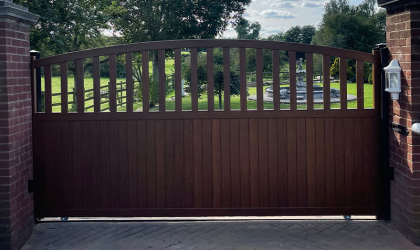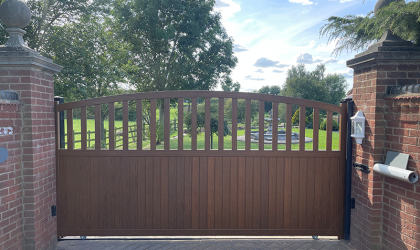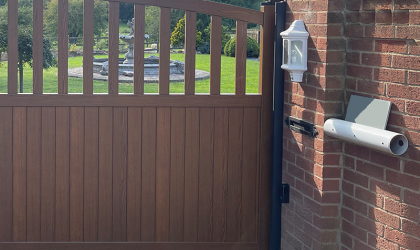AGD Systems was contacted to install an aluminium sliding gate in place of original swing gates that had become problematic due to age. A design was agreed for an aluminium sliding gate with open top bars in a coated wood grain style to match the style of property. Drawings were issued and agreed for the aluminium gate to be 3.8m long to span the opening and a further 700mm section for the automation. The gate was ordered and when ready AGD attended site to start the installation. We started by stripping out the old automation and controls, once this was done the block paving was removed in the track area and stored for reuse.
The ground was scanned for services (pipes or electrical cables) once satisfied the ground was excavated with a mechanical digger to produce a 300mm x 300mm trench across the opening and 4m to the rear. This was shuttered 100mm below ground to allow for the track to be bolted to it and the block paving to be re-laid to ground level. Either side of the opening the excavation was extended down to 700mm and two 120mm steel galvanised and powder coated black posts were installed into the holes ready for concreting.
Concrete was mixed and poured into the excavation and levelled off 100mm below finished ground level making sure the posts and surface were level and smooth. Once left to cure for a week the ground track and motor plate were bolted down level and straight, ducting was run to the far side for safety device wiring and an exit loop was placed under the ground to detect vehicles when exiting and automatically open the gate. The block paving was then re-fitted up to the ground track leaving just a 20mm round bar out of the ground for the gate wheels to run on and minimising the amount a vehicle has to drive over.
The gate was then lowered onto the gate track and secured via a roller set bolted to the top of the 120mm post, physical end stops were installed consisting of a catch cup at the closed position (also to prevent the gate from being pushed into the property) and a steel post concreted in to physically stop the gate moving past its open limit. The automation motor was then fitted to the motor plate and toothed drive rack fitted to the gate with specialist aluminium fixing for the motor drive cog to mesh with giving the movement.
All wiring was connected, and safe edges fitted, one on the front of the gate with a wireless transmitter to prevent entrapment when closing and three more on the post and wall to prevent entrapment. Photo beams were also fitted to protect vehicles if parked in the gate opening. The system was then setup and tested and handed over to the customer after a training session which included manual release methods, safety, and user information on servicing etc. The customer was then left with remote controls for the gate operation and a wiring diagram for the open/close connections as he had employed a home automation engineer to connect the gate to their existing home automation as opposed to AGD Systems providing an intercom or keypads.


